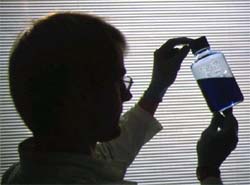
|
This work does not change treatment now, but could lead to the development of a new class of HIV drugs. It was widely reported in the press. The research team at ADARC, headed by Linqi Zhang, believes that this factor includes three previously known chemicals called alpha defensins. Through various tests, they found that these chemicals were produced by stimulated CD8 cells of three of the long-term non-progressors they are studying (they picked their three best non-progressors among their patients, in order to have the best chance of identifying how their cells are able to keep HIV in check). After the chemicals were identified -- with the help of a protein-chip technology that allows rapid, sensitive testing -- it was found in laboratory tests that antibodies to those chemicals could largely eliminate the anti-HIV activity of those cells -- helping to confirm that an anti-HIV factor is really these three defensins. Only one to two percent of HIV patients are long-term non- progressors. Since 1986 it has been known that their cells can produce some substance or substances that inhibit HIV.(2) In 1995 it was shown that some of the activity was due to three other chemicals called beta chemokines. But the beta chemokines only block some HIV viruses, those that use the CCR5 receptor on the CD4 cell to enter the cell -- not viruses that use the CXCR4 receptor, which often evolve later in HIV infection. The defensins are believed to block all HIV, and to act through a completely different mechanism -- possible involving viral transcription, instead of viral entry into the cell. These chemicals have been found not only in long- term non-progressors but in at least some healthy uninfected persons as well, and in several primate species. However they are seldom found in HIV patients who are not non-progressors. The defensins would be very difficult to use as drugs, if they could be used at all. But when their action is better understood, it may be possible to devise other treatments that have the same effect. Another approach would be to maintain and enhance the body's ability to produce defensins. Either kind of treatment might convert patients into long- term non-progressors who would not become ill despite HIV infection. References (1) Zhang L, Yu W, He T and others. Contribution of human alpha-defensin-1, -2, and -3 to the anti-HIV activity of CD8 antiviral factor. SCIENCE EXPRESS. September 26, 2002. (2) Walker CM, Moody DJ, Stites DP, and Levy JA. CD8+ lymphocytes can control HIV infection in vitro by suppressing virus replication. SCIENCE. December 19, 1986; volume 234, number 4783, pages 1563-1566. AIDS Treatment News Published twice monthly Subscription and Editorial Office: 1233 Locust St., 5th floor Philadelphia, PA 19107 800/TREAT-1-2 toll-free email: aidsnews@critpath.org useful links: http://www.aidsnews.org/ Editor and Publisher: John S. James Associate Editor: Tadd T. Tobias Statement of Purpose: AIDS Treatment News reports on experimental and standard treatments, especially those available now. We interview physicians, scientists, other health professionals, and persons with AIDS or HIV; we also collect information from meetings and conferences, medical journals, and computer databases. Long-term survivors have usually tried many different treatments, and found combinations that work for them. AIDS Treatment News does not recommend particular therapies, but seeks to increase the options available. AIDS Treatment News is published 24 times per year, on the first and third Friday of every month, and print copies are sent by first class mail. Email is available (see below). Back issues are available at http://www.aidsnews.org/ To subscribe, you can call 800-TREAT-1-2 or 415-255-0588: |
|
 On September 26 scientists at the Aaron Diamond AIDS Research
Center (ADARC) announced that they had identified a
significant contributor to a long-sought antiviral factor,
secreted by certain CD8 T-cells, that inhibits HIV
replication.(1)
On September 26 scientists at the Aaron Diamond AIDS Research
Center (ADARC) announced that they had identified a
significant contributor to a long-sought antiviral factor,
secreted by certain CD8 T-cells, that inhibits HIV
replication.(1)